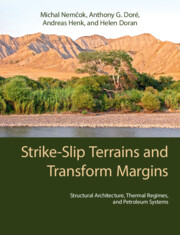 Strike-Slip Terrains and Transform Margins
Strike-Slip Terrains and Transform Margins Book contents
- Strike-Slip Terrains and Transform Margins
- Strike-Slip Terrains and Transform Margins
- Copyright page
- Dedication
- Contents
- Acknowledgments
- Introduction
- 1 Basic Description of Structural Architecture in Transform Margin Settings
- 2 Mechanics of Strike-Slip Faulting and Transition to Drift Phases
- 3 Determination of Continental, Proto-oceanic, and Oceanic Crustal Boundaries
- 4 Determination of Timing of Strike-Slip Events and Continental Breakup along Transforms
- 5 Role of Lithospheric Composition and Compositional Variations in Evolving Structural Styles
- 6 Role of Pre-existing Anisotropy in Evolving Strike-Slip Structural Styles
- 7 Role of Syn-tectonic Deposition and Erosion in Evolving Structural Styles
- 8 Fluid Flow Systems and Magmatism
- 9 Role of Pre-tectonic Heat Flow in Thermal Regimes
- 10 Role of Stratigraphic and Structural Architecture in Thermal Regimes
- 11 Role of Syn-tectonic Deposition and Erosion in Thermal Regimes
- 12 Role of Deformation on Thermal Regimes of Transform Margins
- 13 Role of Fluid Flow on Thermal Regime
- 14 Models of Source Rock Distribution, Maturation, and Expulsion
- 15 Models of Reservoir Quality Distribution
- 16 Sealing Characteristics
- 17 Models of Hydrocarbon Migration
- 18 Trapping Styles
- Bibliography
- Index
9 - Role of Pre-tectonic Heat Flow in Thermal Regimes
Published online by Cambridge University Press: 23 January 2025
- Strike-Slip Terrains and Transform Margins
- Strike-Slip Terrains and Transform Margins
- Copyright page
- Dedication
- Contents
- Acknowledgments
- Introduction
- 1 Basic Description of Structural Architecture in Transform Margin Settings
- 2 Mechanics of Strike-Slip Faulting and Transition to Drift Phases
- 3 Determination of Continental, Proto-oceanic, and Oceanic Crustal Boundaries
- 4 Determination of Timing of Strike-Slip Events and Continental Breakup along Transforms
- 5 Role of Lithospheric Composition and Compositional Variations in Evolving Structural Styles
- 6 Role of Pre-existing Anisotropy in Evolving Strike-Slip Structural Styles
- 7 Role of Syn-tectonic Deposition and Erosion in Evolving Structural Styles
- 8 Fluid Flow Systems and Magmatism
- 9 Role of Pre-tectonic Heat Flow in Thermal Regimes
- 10 Role of Stratigraphic and Structural Architecture in Thermal Regimes
- 11 Role of Syn-tectonic Deposition and Erosion in Thermal Regimes
- 12 Role of Deformation on Thermal Regimes of Transform Margins
- 13 Role of Fluid Flow on Thermal Regime
- 14 Models of Source Rock Distribution, Maturation, and Expulsion
- 15 Models of Reservoir Quality Distribution
- 16 Sealing Characteristics
- 17 Models of Hydrocarbon Migration
- 18 Trapping Styles
- Bibliography
- Index
Summary
This chapter goes through a list of potential thermal regimes occurring prior to the development of the strike-slip setting or transform margin. These have a strong impact on the thermal regime among all controlling factors. This is due to the fact that the thermal regime affects the host continental lithosphere in many different aspects, such as its thickness, metamorphic reactions, melt formation, rheological zonation, and mechanical behavior. Following a brief summary of basic concepts of heat transport and generation, and heat flow presently observed at the Earth’s surface, the chapter discusses thermal regimes and temperature distribution with depth that can exist in continental lithosphere affected by transform margin formation. It sets the stage for the subsequent evolution, which is strongly dependent on the initial subsurface temperature field. Although this influence progressively diminishes as the transform margin evolves, the knowledge of pre-existing thermal regimes may also help to understand spatial variations along a specific transform margin segment and present-day differences between transform margins.
Keywords
- Type
- Chapter
- Information
- Strike-Slip Terrains and Transform MarginsStructural Architecture, Thermal Regimes and Petroleum Systems, pp. 328 - 333Publisher: Cambridge University PressPrint publication year: 2025
